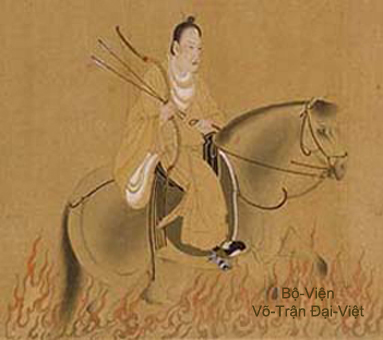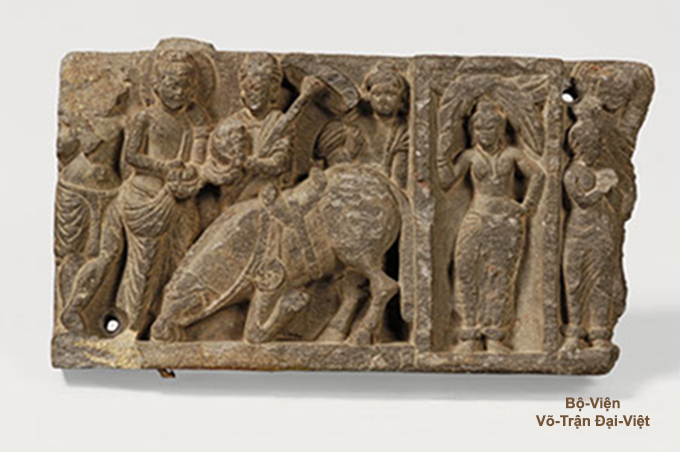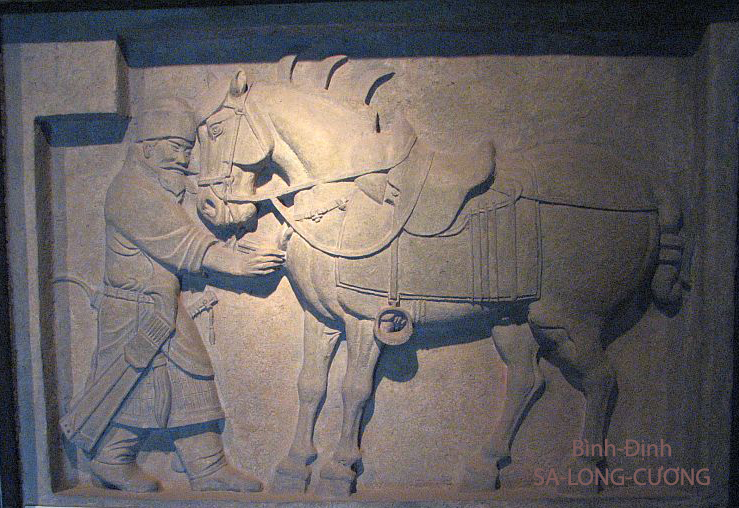III.
The War Horses

The Horse and the Elephant are two animals particularly prized in our country's history. War horses and War Elephants have brought their contribution to victories gleaned in wars against invaders.
Two organisms have been founded for their care, their food and their training : there were the Institut of Elephant and the Institut of Horse.
In the year of 1509, Emperor Lê Uy Mục had established two Inspection Offices of Royal Elephants and of Royal Horses.
In «The Đại-Nam Register of Traditions and Facts Compendium established by Imperial Order » ( Khâm định Đại Nam Hội Diễn Sự Lệ) from ”Institut of the Nation History (Quốc-Sử Quán) one book numbered 175 for determinating the hippological problems concerning Horses Farming, Horses Selection, Horses Diagnostic, Horses Show, Horses Smartening...
The Horses reared in the capitale belonged to the Royal Stable Institut (Thượng-Tứ 尙) ; those reared in Relay Posts in the area around the roads from provinces belonged to citadels, commanderies, regional armies ...
The Ancients have discerned clearly the rôle and les responsabilities of administrators, officiers s'occupant of each category of Horses. They have elaborated functions of Médecins Zoologues for les soins and les guérisons des Horses, for helping them to aider à mettre bas, like Vétérinaires spécialistes des Chevaux d'aujourd'hui.
Since the Mongolians Nguyên - Yuan had invaded our country for the first time in the year of 1257 and another times in 1285 and in 1288, thousands and thousands of war horses from north mongolian steppes have been transported into our nation.
When the defeated Mongolian troops had fleed, a certain number of these war horses have been captured, the another have been lost in the forests and became wild horses. Our national horses had crossbred with horses thoroughbred lfrom mongolian steppes, from Vân-Nam - Yunnan, from Kinh-Bắc (North China), from Ferghana (Tân Cương) that our northern ennemies have taken in their militaries campaigns throughout several invasions.
Lê-Quí-Ðôn had writen in «About a Library» ("Vân-Ðài Loại-Ngữ") : « The provinces of Tuyên-Quang and Cao-Bằng from our kingdom, élevèrent de très nombreux horses. Au department of Phú-Yên, appartenant à la région de Quảng-Nam, les chevaux furent plus nombreux encore : par centaines et par milliers, they formèrent des hordes comme celles des bovins ou des ovins. Mêmes les women commerçantes montèrent à cheval ; elles utilisèrent les chevaux pour transporter des marchandises qu’elles vendirent en même temps que their own horses. »
War Horses differ very far from Horses used for communications des informations and distinguish still more with Pack-Saddle Horses and Carthorses (Drafthorrses).... War Horses were selected from categories of « Kỳ »(騏) horses and « Kí »(驥) horses which were little-known, precious and rare horses ; it was the category of Battle Horses. While « fearful horses - ngựa Nô», « base horses - ngựa Đài » used for the transport ; there was « horses of pack-saddle - ngựa Thồ ».
Outclassing all precious horses are those reserved to Emperor and Generalissimos going to the front.
The thoroughbred War Horses the most prized by Far East Generalissimos in the bygone days were often those of horses called « Thiên-Lý-Mã » (Horses covering thousand of miles), as the one of « Horses sweating blood » (the Akhal-Téké), or those of Arabian Horses, called «Heavenly Horses - Thiên-Mã», as the Iranian Jaf and the Arabian Purebred, imported from far countries (Ferghana, Turkménistan, Persian-Sogdian) by the Silk Road.
The War Horses request 4 Paces of Galop and 3 Levels of Jumping Height, and they request 9 Qualities. They are divided into 8 kinds of Brilliant Horses.
Among specifical names used for designing colors of coasts, shapes or characteristiques of medieval horses in our country, as in China, there's a certain number of following terms : «Horse - Mã»(馬), «Hare -Thố» (兔), «Dragon - Long»(龍), «Foal - Câu»(駒), «Hooves - Đề(蹄), «The Excellent Kỳ»(騏), «The Robuste Kí»(驥), «The Fearful - Nô (駑), «The Base - Đài» (駘) for naming horses and there's a certain number of adjectives as : «Splendid - Tuấn» (駿), «Cheerful- Lạc» ((樂), «Precious - Bảo» (寶), «Well-Built - Phiêu» (膘) for qualifying them.
I - Famous War Horses of Lý and Trần Dynasties
When we talk about War Horses, we can't leave out to speak about two famous battle horses : there were « Song-Vỹ Hồng » of illustrious generalissimo Lý-Thường-Kiệt (1019-1105) and « Nê-Thông » of emperor Trần-Duệ-Tông (1372-1377).
«Song-Vỹ Hồng» (Chestnut Horse with Two Tails) was a War Horse with the Golden Chestnut Horse coast with a long tail of two colors : golden chestnut color and washed-out color on both sides. When it galops, it seemed like a divine horse with two tails, so it was called « Song-Vỹ Hồng », that meaned «Golden Chestnut Horse with Two Tails». It was the war horse of llustrious generallissimo Lý-Thường-Kiệt (1019-1105), famous vietnamese general having pacified the Champa, having fought the Song ang having conquired the two most great southern provinces of China.
«Nê-Thông» (Night-Blue with Metal Mud-Grey Highlights horse) was a splendid horse having an extremely rareful and precious coat, with the truthly marvellous mixing of three colours of white, black and Night-Blue. There was the battle horse of king Trần-Duệ-Tông (1372-1377) during the punitive strike conducted by this emperor himself against the Champa in 1377.
II - Famous War Horses of Tây-Sơn Dynasty
Accordind to the book « Tây-Sơn's Figures » from Đinh-Sĩ-An (originary of Bình-Khê, province of Bình-Định, an ilustrious well-read under the reign of Quang-Trung), Five Divine Horses from Tây-Sơn period (1700-1800) are quoted :
1 – The « Bạch-Long Câu » of king Thái-Đức Nguyễn-Nhạc : a magnificent powerful horse with long leggs, slender body and beautiful silhouette. His coat is white as snow, his mane and his tail are long with fine hair as of the silk. It runs swift as the wind, with a light pace as it flews.
2 – the Xích-Kỳ (a horse from northern steppe, tribut offert by Khmers), which was owned by king Nguyễn-Phúc-Khoát and took as war booty by Amiral of the Left WIng Army Nguyễn-Văn-Tuyết. It's a Cherry Bay Horse, with a mane and a tail as black as jais.
3 – The Ô-Du of Generalissimo Đặng-Xuân-Phong, Ebony Black Horse, still called Travelling Crow-Black Horse, with leggs as thin as those of dears. It walks carefully and supple as a tiger ; in galop, it runs so fast that you'd think it flews.
4 – The Ngân-Câu, an Akhal-Teke of Lady Generalissimo Bùi-thị-Xuân. It's a powerful and tall white horse .
5 – The Hồng-Lư, an another Akhal-Teke of celebrious Generalissimo Lý-Văn-Bưu. It's a splendid Chestnut Horse. At the first view, it appears as an ordinary horse, with long legs holding thin feet, svelte silhouette revealing his ribs as a starving horse. But when we watch it well, we see that it owns particular traits, with a mule's head. It has a capricious nature, indomitable and only his master can riding it with facilities. His neigh always terrorize other horses and scares them off.
In addition, to these five cebrious horses of Tây-Sơn, the War Horse of Bằng-Châu and the Even of Horses Linh-Phong (Sacred Winds) are often quoted :
- The War Horse of Bằng-Châu is the mount of Mr Đinh-Cương at Bằng-Châu (sous-préfecture of An-Nhơn), grand uncle maternal of three founder brothers of Tây-Sơn. It's a horse with white coat as the snow, with eyes which are red as ardent coal, speed like the wind, being able to cover thousands of lieues. It's broken in for crossing up aw well rivers as fire under the order from his Master. It knows returning in the military base for annnouncing the detress messenger from his master on the battle field, by neighing and pawing the ground.
- The Even of Horses Linh-Phong (Vents Sacrés) is constituted by the Chesnut Horse of Generalissimo Mai-Xuân-Thưởng (1860-1887), Leader of political movement Cần-Vưong in opposition against french force of occupation, and by the Black Ebony Horse of Commandeur Trần-Tân. These two horses, descendants of those from northern China, are of an extreme loyalty with their recpective master, go always together and get on wonderfully.
III - Famous War Horses of Nguyễn Dynasty
We quote there, by documentary title, the names of seven famous horses of Minh-Mạng Emperor from NGUYỄN's Dynasty in 19e century :
-
Phúc-Thông
-
Cát-Thông
-
An-Tường-Ký
-
Thần-Lương
-
Phúc-Lưu
-
Cát-Lưu
-
Thiên-Mã.
From these seven horses, two most prized by emperor Minh-Mạng of NGUYỄN's Dynasty were an Arabian Purebred baptized « Thiên-Mã » (Heavenly Horse), imported in 1830 and « An-Tường-Ký » i.e. «Excellent Horse going at an Amble».

Commemorative Statues of the Battle Horse and the War Elephant
Emperor Thiệu-Trị
(1841~1847) Mausoleum
NGUYỄN Dynasty (1802~1945)
IV - Other Famous Horses of the Far East
By anecdotal way, we can also quote :
- The Kathiawari Horse, called « Kiền-Trắc » (Kantaka ), characterized by lyre shaped ears (inward curving ears), owning a kind of swift (called Revaal) very confortable, and ridden in the past by prince Sidharta who became later Bouddha Çakyamûni ;

The precious Horse Kantaka was kneeling down and bending one's head for making farewells to Prince Sidharta.
- The famous Akhal-Téké « Xích-Thố - 赤 兔 - Red Hare », ridden by the Generalissimo Duke Quan Vân Trường - 關 雲 長 (162-220) in the Three Kingdoms Period.
- The no less famous war horse « Đích Lư - 的 驢 - True Licorne » of Lưu Bị (Liu Bei - 劉 備) (161-223), eldest sworn brother of Quan Vũ ( Guan Yu - 關 羽 ) Generalissimo Duke ;
- The renamed horse « Ô Vân Đạp Tuyết - 烏 雲 踏 雪 - Black Cloud treading down the Snow », a war horse owning ebony black coast with four white stockings of valiant Generalissimo Trương-Phi (Zhang Fei - 張 飛) (167-221), one among Five Celebrious Generalissimo from THỤC-Hán (Shu Han - 蜀漢) kingdom in the Three Kingdoms Period, and younghest sworn brother of Suzerain Lưu-Bị (Liu Bei - 劉 備) and Generalissimo Duke Quan Vũ ( Guan Yu - 關 羽 ) ;
- An another famous Akhal-Téké called « Ô-Chuy - 烏 隹 - Piebald Horse », the war horse owning ebony black coast with white spots with blue silver-grey glints very rare of invincible sovereign Xiang Yu ( 項羽 - Hạng-Võ) of CHU (楚 - Sở), at the time of military conflicts between HAN and CHU ;
- The famous war horse « Hoàng-Phiêu - 黄 膘 - Well-Built Horse » of Generallissimo Tần Thúc Bảo, became illustrious with his dexterity in the Blade-Breaker wielding, under the TANG Dynasty.
- The famous war horses of Tao-Tháo - 曹 操 (Cao Cao), in the Three Kingdoms Period (220~280) :
. « Tuyệt-Ảnh - Shadowless » (Jueying - 绝 影)
. «Trảo Hoàng Phi Điện - Yellow-clawed Flying Lightning » (Zhuahuang Feidian - 爪 黄 飛 电).
- The exceptionnels horses « Thiên Lý Phong » (Qian Li Feng - 千 里 風) and « Vạn-Lý-Vân (Wan Li yun - 萬 里 雲» stealed from Bác-Vương (Pa Wang - 博 王) by Mạnh-Lương (Mèng Liáng -
孟 良).
- The six illustrious war horses of Đường-Thái-Tông (Tang Taizhong), carved in the stone relief, called the «Six Steeds of Zhaoling - Chiêu Lăng Lục Tuấn» (zhào líng liù jùn - 昭 陵 六 骏) (Zhaoling is Tang Taizong's mausoleum, where the stone reliefs were originally located) :
1. Thập-Phạt-Xích (Shi Fa Chi - 什 伐 赤 - Numerous Warlike Expedition Red Horse) :
- War Horse with Dark-Chestnut Cherry Bay coat, ridden in the military campaigns against warlords Vương Thế Sung (Wang Shi Chong -
王 世 充) and Đỗ Kiến Đức (Dou Jian De -
竇 建 德), during 620-621.
2. Thanh-Chuy (Qingzhui - 青 騅) - Black Horse with Blue-Grey glints) :
- Piebald War Horse with Blue-Grey glints coat, ridden in the military campaign against Đỗ Kiến Đức (Dou Jian De-
竇 建 德), in 621.
3. Đặc-Lặc-Phiếu (Te Le Biao - 特 勒 骠 - Yellow Horse with an Exceptional Bridle) or Đặc Cần Phiếu (Te Qin Biao-
特 勤 骠 - (Yellow White-speckled Horse with an Exceptional Haste) :
- Dun War Horse with White-speckled Yellow coat, ridden in the military campaign against Tống Kim Cang (Song Jin Gang - 宋 金 剛), during 619-620.
4. Quyền-Mao-Qua (Quan Mao Gua - 鬈 髦 騧 - Curly-haired Yellow Horse with Black Mouth) :
- Dun War Horse with Black mouth and Curly mane, ridden in the military campaign against Lưu Hắc Thát (Liu Hei Da
- 刘 黑 闼), in 622.
5. Bạch-Đề-Mã (Bai Ti Ma - 白 蹄 马 - (White-hoofed Black Horse) :
- War Horse with Black coat and white hooves, ridden in the military campaign against Tiết-Nhân-Quý (Xue RenGui - 薛 仁 貴), in 618.
6. Táp-Lộ-Tử (Sa Lu Zi - 飒 露 紫 - Obvious Whirlwind Purple Horse) :
- Crimson Chestnut War Horse, ridden in the battle for Lạc Dương (Luoyang - 洛 陽) against Vương Thế Sung (Wang Shi Chong -
王世充) of Tùy (Sui - 隋) Dynasty (581-618). Táp-Lộ-Tử
(Sa Lu Zi) in the low-relief is the only war horse represented with a man standing beside ; this is the general Khâu-Hành-Cung (Qiu Xinggong 丘 行 恭 ) pulling an arrow out of this celebrious war horse's chest.

The « Obvious Whirlwind Purple Horse » (Táp-Lộ-Tử - 飒 露 紫 )
and the valiant general Khâu-Hành-Cung (丘 行 恭)
Bình-Định SA-LONG-CƯƠNG TRỊNH Quang Thắng |
I – The Military Statute
II – The Military Horses Riding
III – The War Horses
IV – The Coats of Horses
Bibliography :
«Đại-Nam Register of Traditions and Facts Compendium established by Imperial Order » (Khâm Định Đại Nam Hội Điển Sự Lệ) from ”Institut of the Nation History" (Quốc-Sử Quán) - book numbered 175, Ed.1856-1884.
« Comments from a LiIbrary » ("Vân Ðài Loại-Ngữ") from Lê-Quí-Ðôn, ED. 1773.
« Complete Book of Việt History » ("Việt-Sử Toàn-Thư") from Phạm-Văn-Sơn.
« The Figures of Bình-Định » ("Nhân-Vật Bình-Định"), from Lộc-Xuyên Đặng-Quí-Định, Ed. of the Author, 1971.
« Martial Arts Men of Bình-Định » ("Võ-Nhân Bình-Định"), from Quách-Tấn and Quách-Giao, Ed. of Youth, Ho-Chi-Minh City, 2001.
« The Tây-Sơn Stars » ("Những Ngôi Sao Tây-Sơn"), from Nguyễn-Văn-Nhân, Ed. of Arts, Ho-Chi-Minh City 2001.
« Famous Generalissimos of Việt-Nam » ("Danh-Tướng Việt-Nam"), from Nguyễn-Khắc-Thuần, Ed.of Education, Ho-Chi-Minh City, 2001.
« The Five Divine Horses of Tây-Sơn » ("Ngũ Thần-Mã Tây-Sơn"), from Thái-Tẩu.
« The Pleasure To Read Chinese Historical Novels » ("Thú Xem Truyện Tàu"), from Vương-Hồng-Sển.
Copyright © 2004 - 2018 by ACFDV - All rights reserved.
